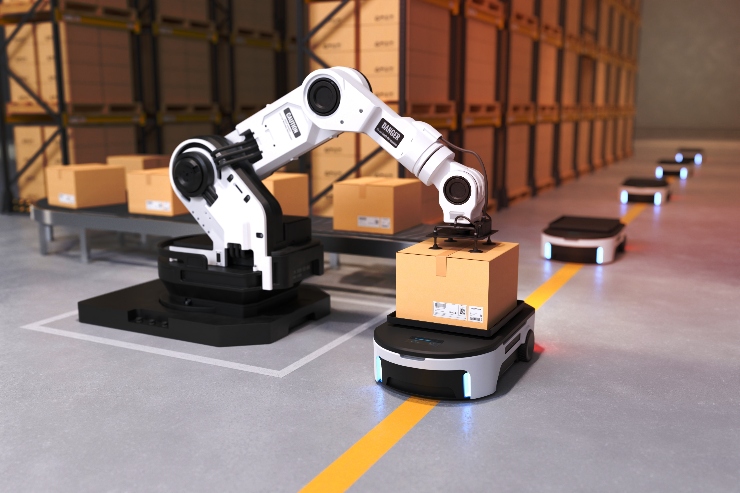
In corporate offices, clients traditionally occupy dedicated and contained spaces that are segregated from staff areas and amenities. These spaces are designed as microcosms for meeting and entertaining, often contained in the most desirable parts of buildings with the best views and with the most luxurious interior design. This approach carefully plans a sequence of arrival spaces and ‘protected routes’ that guide clients to these areas, which would often be the only spaces visitors see.
Working with our clients, we are now consciously shifting away from this level of segregation in the workplace, dissolving the line between client and staff space (between “back of house” and “front of house”). This new approach involves moving towards creating carefully choreographed work environments, where staff and clients work side-by-side. These designated collaborative spaces, which could simply be a café or breakout space, are used to “open the front door” to the business, showing clients the working culture of the organisation and driving an appropriate shift to informality.
We have found that offices have become not just a place to pitch to your clients, but also space where businesses can collaborate with them for longer periods of time. This shift in dynamic is based on adding variety to the client experience, with spaces that are formal or informal, closed or open.
In our experience and from client feedback we have collated, the rise of more flexible and relaxed environments has been proven to forge closer bonds, with conversations becoming more discursive and collaborative. By virtue of sharing, these open and more inclusive working environments become social spaces where informal introductions can be more easily made, creating opportunities for clients to meet other members of the team from different parts of the business.
Creating environments that can be used by both staff and clients also boosts the utilisation of that space, which increases efficiency. In essence, you are making that space work harder. This more relaxed and open approach also benefits staff, as the flexible spaces they have access to will have better facilities and finishes, and usually a higher standard of fit-out.
It is not just young tech companies adopting these workings patterns; we have been working with several banks, solicitors and professional service providers on trying to achieve a more vibrant and flexible client experience. ID:SR Sheppard Robson has recently completed the new London office for the Commonwealth Bank of Australia (CBA), where a key element of the project brief was to boost collaboration between internal teams and also with clients.
The key to this was creating a more relaxed environment for the bank’s team and clients to collaborate. This resulted in designing a dedicated space for an “innovation lab”, an open and flexible series of work settings that was specifically designed to move away from a ‘pitch’ setting and support longer periods of collaborative working.
There are stringent requirements for privacy at CBA, with the design including a range of meeting rooms and a boardroom. However, acknowledging a requirement for communicating with clients in numerous ways, the formal meeting spaces could not be static. They are designed as a series of private meeting rooms that can open up to create one large space, connecting to the reception, to form an even larger area for events.
This did not pigeon-hole the space as either for clients or staff and wanted to create a design that had the potential to transform the nature of the space from private to social in a matter of minutes. The major factor here is bringing large groups of people together; this could be for clients, staff or a mixture of the two. This social infrastructure enabled CBA to host events within their office rather than hiring external venues, putting the company’s brand and ways of working centre-stage.
It is likely that these flexible spaces will require a greater level of investment up front, as the furniture and fittings for flexible spaces do have a cost-premium attached. However, once created, these assets will be able to work harder and be inherently more agile.
Privacy is still fundamental to the way offices work and we certainly don’t see a move to purely informal and social spaces. However, we anticipate that the way in which organisations accommodate clients within their office will continue to shift, with variety and agility being the cornerstones of successful offices.

♣♣♣
Notes:
- The post gives the views of its author, not the position of LSE Business Review or the London School of Economics.
- Featured image credit: Commonwealth Bank of Australia project, provided by the author. This image is NOT under a Creative Commons licence. All rights reserved.
- Before commenting, please read our Comment Policy.
 Robert Myers is partner at ID:SR, the interior design group for architecture firm Sheppard Robson. He has extensive experience in both workplace design and strategy, having completed projects for a number of major businesses, including recent designs for The Commonwealth Bank of Australia and Arcadia Group.
Robert Myers is partner at ID:SR, the interior design group for architecture firm Sheppard Robson. He has extensive experience in both workplace design and strategy, having completed projects for a number of major businesses, including recent designs for The Commonwealth Bank of Australia and Arcadia Group.





